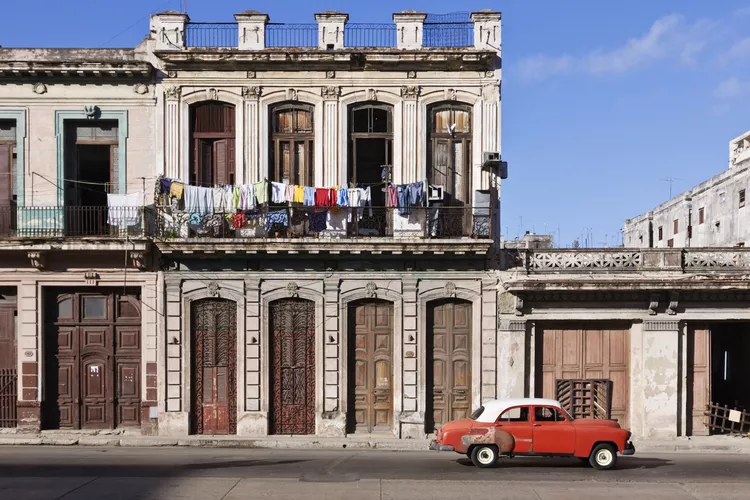Cuba Travel Guide: Essential Information for Your Trip
Some countries are more complicated to visit than others. Cuba is among them. Figuring out how to travel to Cuba is one thing, but once you land at Havana’s José Martí International Airport, you’ll quickly notice there’s no rail station, no free Wi-Fi, and no ATMs that accept American debit cards. While it’s now easier to travel to Cuba than it’s been in decades, navigating this Communist island nation—which still has a strained political relationship with the United States—is a unique challenge. If you’re an American planning to visit Cuba, here’s what you need to know.
Getting to Cuba
Americans can still visit Cuba; however, in October 2019, the Trump administration announced that all commercial U.S. flights must discontinue routes to nine destinations within Cuba (not including Havana). Therefore, Havana will need to be your main point of arrival and departure within the country.
Moreover, in June 2019, the Trump administration announced new restrictions on group travel to Cuba. Cruises and group tours are no longer options for Americans looking to travel to Cuba, but commercial flights are still available to Havana from airlines including American, Delta, Southwest, and JetBlue for travel that falls into one of the acceptable categories. Tourism isn’t one of those categories, but support for the Cuban people is. This option is frequently cited by visitors planning to pump cash into the pockets of local private businesses.
Visas, Vaccines, and Health Insurance
You’ll need both a visitor visa and health insurance to visit Cuba, but there are no recommended vaccines. Fares with U.S.-based airlines typically include the cost of Cuban health insurance for up to 30 days. Additionally, visas are issued at departure airports for $50, although some airlines may charge additional processing fees.
Bringing Cash to Cuba
U.S. credit and debit cards won’t work in Cuba, nor do Venmo or PayPal. Therefore, you’ll need good, old-fashioned dollar bills. You can convert them into Cuban Convertible Pesos at airports, hotels, banks, and foreign exchange offices for a 10 percent fee. You won’t be able to bring more than $5,000 with you, but unless you’re an incredibly big spender or staying for a very long time, that should be plenty. Budget at least $25 to $50 a day for meals and activities depending on your travel style. Accommodations and activities can be arranged and paid for in advance via Airbnb.
Getting Around Cuba
Cuba doesn’t have an extensive public transit system, nor does it offer rideshare services like Uber and Lyft. Moreover, car rentals are complicated and expensive, especially without a credit card. Local buses are available, but figuring out the system can be more challenging than in the average capital city. Consequently, many travelers opt for private taxis, often in the form of classic American cars, for in-town travel and trips across longer distances. Government cabs and tuk-tuks are also available, while pedicabs are plentiful in tourist districts.
Internet Access in Cuba
Wi-Fi is available in Cuba, but it won’t be free or easy. You’ll need to be in a location with a Wi-Fi network and purchase a prepaid access card before you can log on. Scratch-off access cards can be acquired at government shops, hotels, and many Airbnbs. Expect to find Wi-Fi networks in public parks, restaurants, hotels, and some Airbnb accommodations. Expect to pay 1 to 2 CUC (around $1-2) per hour of internet access. Remember to log out of your card between sessions, or the clock will keep ticking. Furthermore, you will need to bring your passport when purchasing Internet cards at a government shop.
Cell Service in Cuba
You may be able to use services from your U.S. wireless carrier, but it will come at a cost. For example, T-Mobile— which generally offers free texts and slower-speed data in many countries—charges $2 per minute for phone calls and $0.50 each for outgoing texts in Cuba. Additionally, data is priced at $2 per MB.
Bringing Back Rum and Cigars
Americans who are 21 or older and traveling to Cuba can bring back one liter of alcohol and 100 cigars without needing to pay additional taxes.
What to Do in Cuba
In Havana, you’ll want to check out the art at Fábrica de Arte Cubano—a performance space, gallery, and dance club spread out over a network of old warehouses and shipping containers. Take a long stroll through Old Havana where you’ll stumble onto the old stomping grounds of Ernest Hemingway. You can explore Cold War-era bunkers under the Hotel Nacional, take a sunset stroll along the waterfront, or participate in a salsa class via Airbnb. Moreover, Airbnb offers a number of bike and walking tours, many of which are led by local students and professors. A few hours outside of Havana in Vinales, you can visit tobacco and coffee plantations to learn about cigars, coffee, and the region’s special guava-based rum. If the beach is more your style, venture to Varadero. Adventurous travelers to the country can indulge in climbing, surfing, or cycling, among other outdoor activities.
Where to Stay in Cuba
Due to economic sanctions, you won’t find a single big hotel chain in Cuba. While there are Cuban government hotels and properties operated by non-U.S. hoteliers, most Americans prefer to stay in private homes called casa particulars, many of which are now listed on Airbnb. In Havana, many of these rentals are located in Vedado, central Havana, and old Havana, each of which is well-positioned to serve as a home base for exploring the city.
What to Bring to Cuba
Years of economic turmoil and trade restrictions have taken a toll on Cuba, leading to shortages of basic items. Gifts of art supplies, toiletries, toys, ponchos, over-the-counter medications, and chocolates are often well-received. Consequently, Cuba is one destination where the daily necessities you leave behind can fulfill real needs. If you’re looking for a reason to overpack, a trip to Cuba is it.





